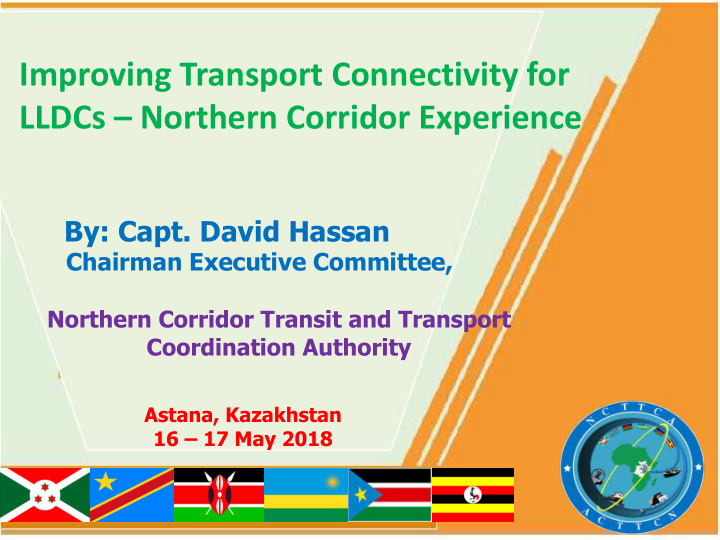



Improving Transport Connectivity for LLDCs – Northern Corridor Experience By: Capt. David Hassan Chairman Executive Committee, Northern Corridor Transit and Transport Coordination Authority Astana, Kazakhstan 16 – 17 May 2018
Ø Transport Corridors in Africa Ø The Northern Corridor Experience: § Institutional Framework § Achievements § Challenges § Way Forward 2
• Africa has a number of Transport Corridors. • The Corridors mainly links Landlocked countries to various maritime ports around the continent. • Transport Corridors facilitate Trade and boost regional integration. • Most African Corridors have management and/or coordination Authorities to promote efficiency.
4
• The Northern Corridor is a Transport Corridor linking the Great Lakes countries of Burundi, DR Congo, Rwanda, South Sudan and Uganda to the Kenyan seaport of Mombasa. • The Corridor also serves Tanzania, Ethiopia and Somalia. • It is a multi-modal Corridor encompassing: Road, Rail, Pipeline and Inland Waterways. • The Corridor is the busiest route in the whole of the East and Central Africa.
• The Northern Corridor Transit and Transport Coordination Authority was established in 1985. • Partner States signed a Treaty known as the Northern Corridor Transit and Transport Agreement. • The Agreement has 11 Protocols aiming at transforming the Corridor into an economic development Corridor. • The Legal Framework took into account the three pillars of Sustainable Transport (social, economic and environmental) • The highest policy making organs are the Council of Ministers and the Executive Committee.
PHYSICAL INFRASTRUCTURE § Development of One Stop Border Posts (OSBPs) 7 developed and operational. § Improvement of road transport infrastructure and network. § Development of the Standard Gauge Railways (SGR) § Implementation of High Speed Weighing in Motion (HSWIM). § Expansion of the Port of Mombasa and development of connecting transport links (road/rail/pipeline). § Program for the establishment of Road Side Stations (RSS).
SOFT INFRASTRUCTURE § Harmonization and automation of Customs Administrative procedures. § Implementation of the EAC Single Customs Territory. § Promotion of voluntary Vehicle Load Compliance. § Development and maintenance of Web-based Northern Corridor Transport Observatory portal. § Implementation of the Northern Corridor Green Freight Program. § Establishment of the Public-Private Stakeholders consultative forum.
• Slow domestication of some of the provisions of the Northern Corridor Agreement and Protocols. • Varying National priorities in the Northern Corridor Member States. • Limited capacity and insufficient financing for infrastructure projects in some Member States. • General Governance issues. • The slow process of regional integration.
§ Sustaining the partnership in infrastructure development (hard and soft). § Strengthening the Transport and Trade Facilitation. § Maintaining strong M&E mechanisms to foster national & regional ownership. § Harmonizing and streamlining of policy , legal framework and regulations. § Enhancing of productive capacity and promoting the private sector investment . § Capacity building at key National, Corridor and Regional levels.
12
Permanent Secretariat of the Northern Corridor Transit Transport Coordination Authority P.O BOX 34068- 80118 MOMBASA, KENYA Tel: +254 41 4470734 Fax: +254 41 4470735 Website: www.ttcanc.org Email: ttca@ttcanc.org 13
Recommend
More recommend